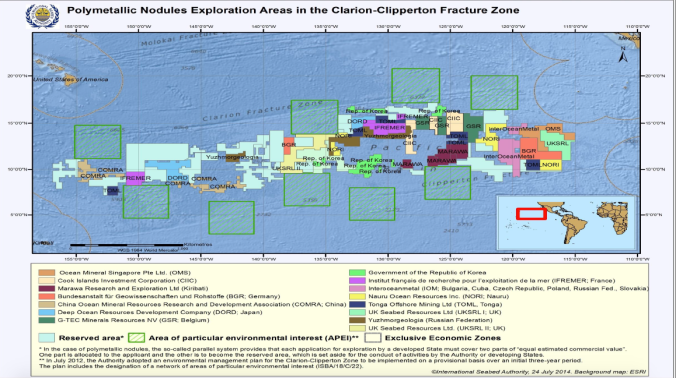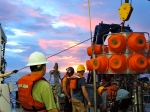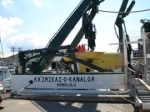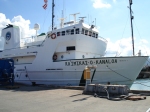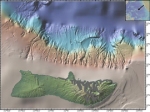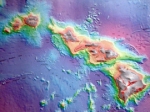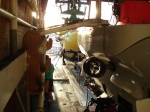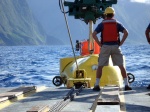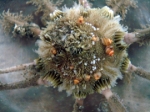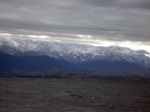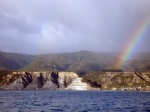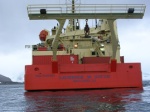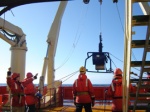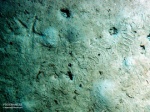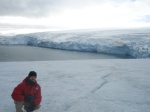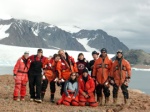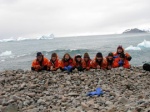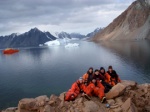ABYSSLINE
Abyssal Baseline Project
Our need for metals is increasing worldwide. To meet this demand, the international mining industry is beginning to explore our ocean depths for new resources. In the Clarion-Clipperton Zone (CCZ), unique conditions have led to the formation of a dense abundance of polymetallic nodules forming on the abyssal seafloor. These nodules have led to an interest in mining this area with 15 exploration areas allocated, each up to 75,000 square km, by the International Seabed Authority. The CCZ is poorly explored and much of what lives there, very little is know about.
The Smith Lab was part of an international program that used the best available technology to undertake benthic biological baseline studies in accordance with ISA environmental guidelines (see ISBA/16/LTC/7 and recommendations from ISA
2002), and used state‐of‐the‐art approaches in deep‐sea ecological, taxonomic, and connectivity studies in the UK-1 Claim Area. We worked in collaboration with scientists from Hawai’i Pacific University, the Natural History Museum in London UK, the National Oceanography Centre in Southampton UK, Uni Research in Norway, the International Research Institute of Stavanger in Norway and Senckenberg am Meer in Germany.
Our studies addressed the following key questions:
1) What are the baseline conditions of community structure and biodiversity for the key benthic biotic components of this ecosystem (megafauna, macrofauna, meiofauna and microbes)?
2) How do community structure, sediment community respiration, and biodiversity vary as a function of environmental parameters (especially nodule cover) within and across three study areas (or “strata”) within the UK-1 Claim Area, and between years within one of these study areas?
3) What is the connectivity at species and population levels between strata and across the CCZ for representative components of the biota?
This program ran from 2013 to 2017. Two cruises were undertaken; the first cruise (AB01) evaluated benthic ecological parameters within the first 30×30 km stratum during September – October 2013. The second cruise evaluated benthic biological studies in the second 30×30 km stratum to evaluate baseline conditions over broader scales,
allowing generalizations across the claim area.
Additional Information:
International Seabed Authority: https://www.isa.org.jm/
More pictures from the first ABYSSLINE cruise (AB01) can be seen on Twitter using #ABYSSLINE
More pictures from the second ABYSSLINE cruise (AB02) can be seen on Twitter using #AB02
The blog run by the Natural History Museum, London and Uni Research team during AB01 and AB02: http://3682m.tumblr.com/
The blog run by the University of Hawaii team during AB02: http://abyssline.blogspot.com/
Submarine Canyon and Scavenger Communities of the Hawaiian Islands
Submarine Canyon and Scavenger Communities of New Zealand
CeDAMar
Census of Diversity of Abyssal Marine Life
CeDAMar was a seven-year field project (2004-2010) within the Sloan Foundation’s Census of Marine Life designed to evaluate patterns of species diversity in the abyssal plains throughout the oceans (3000–6000 m). This aimed to provide a baseline for global-change research and a better understanding of historical causes and ecological factors regulating biodiversity. Specific questions addressed included the following:
• How many species are there in the abyssal deep sea?
• Are cosmopolitan species the abyssal norm?
• Are there latitudinal gradients in species richness?
• Are there biodiversity hotspots in the abyss?
• How do diversity and species ranges vary with organism size?
• What environmental factors, including overlying primary productivity, are correlated with biodiversity at the abyssal seafloor?
• Are there biogeographic barriers to the distribution of abyssal fauna?
• What role has geological history played in determining diversity levels of specific basins?
CeDAMar consisted of an internationally-integrated series of field projects, focused on six themes: (1) Latitudinal gradients in the Atlantic Ocean, (2) Diversity and biogeography of Antarctic deep-sea fauna, (3) Biodiversity and biogeography of the abyssal Pacific, (4) Diversity patterns in the warm abyss of the Mediterranean Sea, (5) Diversity versus food availability in the Indian Ocean, (6) Time-series analyses of abyssal fauna, (7) Evolution in the North American Basin. These field projects included sampling expeditions to abyssal regions of most of the major ocean basins, with research cruises from 2002 to 2009.
FOODBANCS-2
Benthic Faunal Feeding Dynamics on the Antarctic Shelf and the Effects of Global Climate Change on Bentho-Pelagic Coupling, FOODBANCS-2
The Antarctic Peninsula exhibits one of the largest warming trends in the world. Climate warming in this region is reducing the duration of winter sea-ice cover, altering both the pelagic ecosystem and bentho-pelagic coupling. We postulated that shelf benthic ecosystems were highly suitable for tracking climate change because they act as “low-pass” filters, removing high-frequency seasonal noise and responding to longer-term trends in pelagic ecosystem structure and export production. We conducted a 3-year study of bentho-pelagic coupling along a latitudinal climate gradient to explore the potential impacts of climate change (e.g. reduction in sea-ice duration) on Antarctic shelf ecosystems. Three cruises were undertaken during summer and winter regimes along a 5-station transect from near Smith Island (63°S) to Marguerite Bay (68.5°S), evaluating a broad range of benthic ecological and biogeochemical processes. Specifically, we examined the feeding strategies of benthic deposit feeders along this climatic gradient to elucidate the potential response of this major trophic group to climatic warming. In addition, we (1) quantified carbon and nitrogen cycling and burial at the seafloor and (2) documented changes in megafaunal, macrofaunal, and microbial community structure along this latitudinal gradient. Overall, insight was gained into the response of Antarctic shelf ecosystems to some of the effects of climate warming (e.g., a reduction in winter sea-ice duration). This project was funded by the National Science Foundation.
LARISSA
Abrupt Environmental Change in the Larsen Ice Shelf System: a Multidisciplinary Approach – Marine Ecosystems
Principal Investigators: Craig R. Smith, Maria Vernet, Cindy Van Dover, Michael McCormick
We conducted an integrated, multi-disciplinary field program to address the rapid and fundamental changes occurring in the Antarctic Peninsula region as a consequence of the abrupt collapse of the Larsen-B Ice Shelf in the fall of 2002. A profound transformation in ecosystem structure and function occurred in coastal waters of the western Weddell Sea. This transformation appeared to be yielding a redistribution of energy flow between chemoautotrophic and photosynthetic production, and to be causing the rapid demise of the extraordinary seep ecosystem discovered beneath the ice shelf, providing an ideal opportunity to test fundamental paradigms in ecosystem evolution. We tested the following hypotheses to elucidate the transformations occurring in marine ecosystems as a consequence of the Larsen B collapse:
1) Cold Seeps: The biogeographic isolation and sub-ice shelf setting of the Larsen-B seep has led to novel habitat characteristics, chemoautotrophically dependent taxa and functional adaptations.
2) Background (Non-Seep) Benthos: Benthic communities beneath the former Larsen-B ice shelf are fundamentally different from assemblages at similar depths in the Weddell sea-ice zone, and resemble oligotrophic deep-sea communities. Larsen-B assemblages are undergoing rapid change.
3) Phytoplankton communities: The previously dark, oligotrophic waters of the Larsen-B embayment now support a thriving phototrophic community, with production rates and phytoplankton composition similar to other productive areas of the Weddell Sea.
To test these hypotheses, and to document rapid changes occurring in the Larsen-B ecosystem, we used a remotely operated vehicle, shipboard samplers, and moored sediment traps to:
a) Sample and characterize microbial, macrofaunal and megafaunal components of the seep community,
b) Evaluate patterns of surface productivity, export flux, and mega- and macrofaunal composition in areas previously covered by the ice shelf and compare them to the open sea-ice zone,
c) Place ecosystem changes within the geological, glaciological and climatological context that led to ice-shelf retreat,
d) Predict the likely consequences on marine ecosystems of ice-shelf collapse in other regions of Antarctica vulnerable to climate change.
These activities were conducted during a cruise in Jan-Mar 2010 to the Larsen-B region, with sediment-trap recoveries occurring 12 and 24 months later. Our efforts significantly advanced the understanding of linkages among the earth’s systems in polar regions and are proposed in the true spirit of IPY. The project was tightly linked to companion projects addressing Marine & Quaternary Geosciences and Cryosphere & Oceans, and to international collaborators from Argentina, Belgium, Canada, Germany, Spain and the United Kingdom. This project was funded by the National Science Foundation.
The blog for this scientific expeditions in the Antarctic can be found here:
http://uhmanoa-antarctic-research-larissa.blogspot.com/
Ecosystem Function of Hawaiian Mangroves
Invasion, pollution and energy flow: Benthic ecosystem function under anthropogenic stressors in the Hawaiian coastal zone
The Hawaiian coastal zone is influenced by a variety of anthropogenic stressors that may alter biogeochemical cycling, including mangrove invasion and fish-cage aquaculture. Mangroves produce tannin-rich detritus and a root-fiber mat that may shift energy flow to microbial pathways, causing a reduction in food availability for commercial and native Hawaiian species. Pulse-chase experiments and measurements of naturally-abundant stable isotopes evaluated biogeochemical cycling and ecosystem function in mangrove sediments in Hawai’i.
Research employed pulse-chase experiments, using 13C- and 15N-labeled algal detritus, to evaluate the impact of mangrove invasion on benthic ecosystem function. We are testing the following hypotheses: (1) Biogeochemical cycling in mangrove sediments favors microbial pathways, yielding greater nitrogen storage and lower macrofaunal assimilation of organic matter than in open sediments. (2) Due to the persistence of a dense root-fiber mat, microbial metabolism is enhanced, and macrofaunal assimilation of organic material reduced, in sediments for years following mangrove removal.
These hypotheses were addressed by adding 13C- and 15N-labeled organic matter to sediment communities from healthy mangroves, mangrove removal sites of varying ages and control sites, and tracing assimilation and mineralization of this material over 4-day periods. The partitioning of 13C into bacterial fatty acids and porewater CO2, and 13C and 15N into faunal biomass, was measured using state-of-the-art geochemical and molecular techniques. In addition, food-web structure in these different communities was assessed using measurements of natural abundance 13C and 15N in meiofauna and macrofauna.
